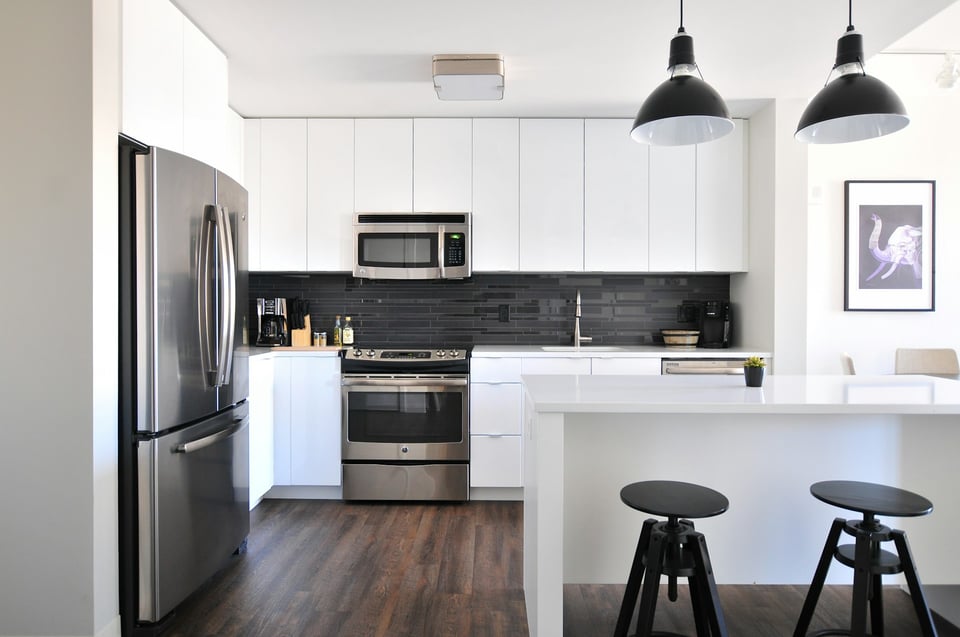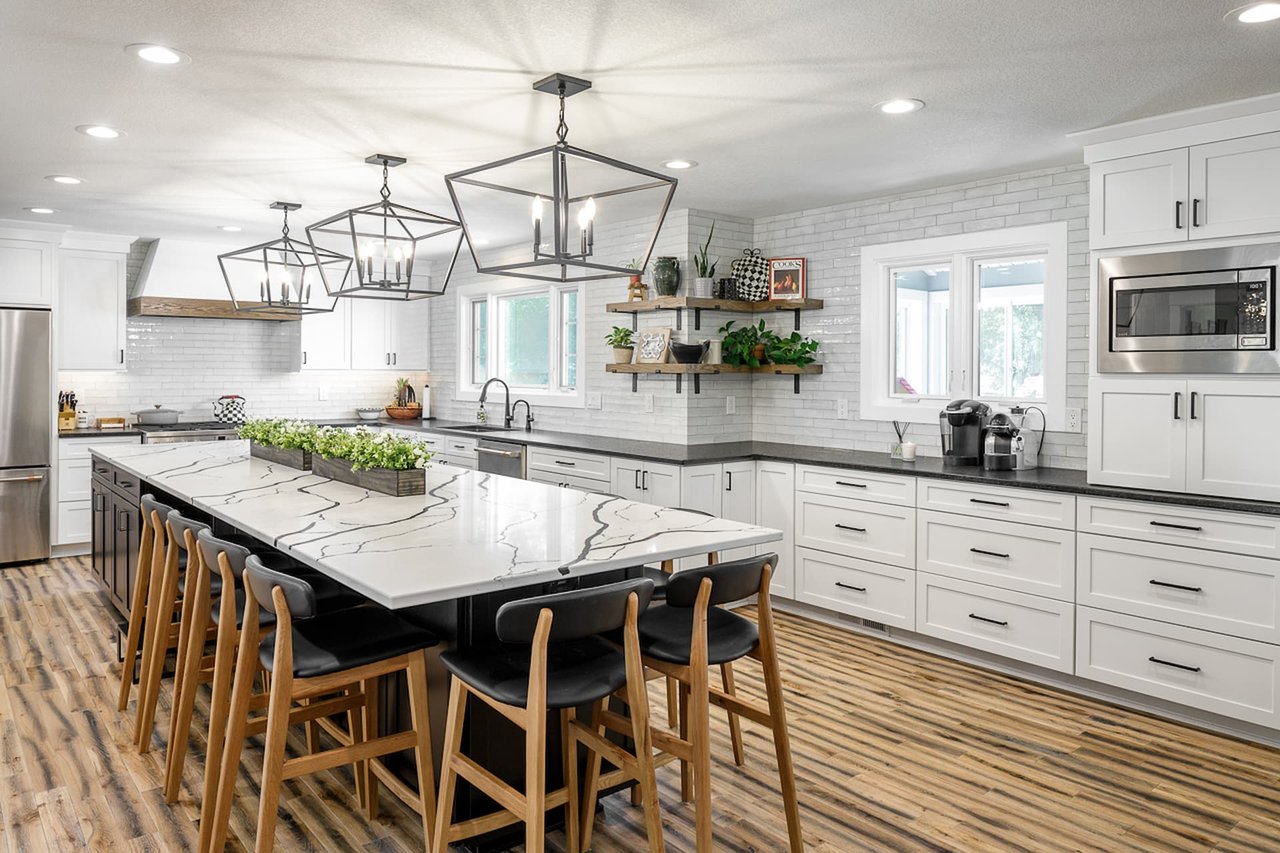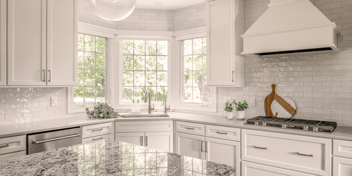7 Min Read
7 Types of Kitchen Light Fixtures
Not so long ago, kitchen lighting was mostly about function rather than style. A combination of fluorescent lights and powerful spots was considered to be enough to light your way through meal preparation and cleaning, and aesthetics were largely secondary.
Here Are the 7 Main Types of Kitchen Light Fixtures
Today, of course, a kitchen is seen as far more than a purely functional space in a house, and modern lighting options need to create a sense of atmosphere, as well as provide adequate illumination. The right kitchen lighting enhances the comfort and appeal of your home, making it a more inviting and enjoyable place for family and guests.
Choosing the right types of light fixtures can help you achieve a desired ambiance or style in the kitchen, transforming an everyday kitchen into a warm and welcoming space for entertaining and relaxing, and create the illumination you need for meal prep.
Because of this, your lighting options should be at the foundation of any kitchen remodeling plans you make. Here are some of the most important points to bear in mind when thinking about which styles and types of lighting fixtures to install.
There’s a huge range of kitchen lighting options available, including curated collections of fixtures that offer the variety to either build your entire décor design around or to add the vital finishing touch to a theme. Here are some of the most popular and effective fixture types.

1. Individual Flush-Mounted Ceiling Lights
For a smaller space or an alcove in a larger kitchen, an individual flush-mounted ceiling light fixture can provide effective illumination without intruding into the room and creating a sense of claustrophobia. Flush mount ceiling lights work best on ceilings that are 8 feet or lower. They are also ideal for bathrooms and bedrooms, where lower ceiling heights and specific lighting needs make flush mounts a practical and stylish choice. But a simple ceiling light doesn’t need to be unassuming or boring. Installing semi flush mounts in transitional areas, like between the kitchen and dining space, can create visual interest without overwhelming the ceiling line.
Try choosing a model with an LED light source in a retro matte black metal frame, which can help brighten up a small space where larger fixtures could be too assertive. Matte black finishes work with a variety of color palettes and effectively hide fingerprints.
Ensure the light is bright enough. Light bulb brightness is measured at 36” above the finished floor (countertop height). For kitchens with medium ceiling height, a semi flush mount fixture strikes the perfect balance between functionality and aesthetic appeal. Semi-flush mounts work well on ceilings in the 9- to 10-foot range. I like to opt for an extra-bright ceiling light and put it on a dimmer switch so you can set a more mellow mood once the evening’s meal prep tasks are complete.
2. Recessed Light Fixtures (Can Lights)
Ambient lights should be the main source of light in the kitchen, and usually this means recessed light fixtures. These lights must be distributed as evenly as possible. Recessed can lights are my go-to choice for ambient illumination, especially when paired with the right recessed lighting housing to optimize performance and safety.
While you can plan your kitchen's recessed lighting in many different ways, the exact placement will depend on your unique space. There are two main ways to arrange can lights in the kitchen: along the perimeter or in two parallel lines. Always check that your recessed lighting housing is IC-rated if you're installing near insulation—this improves safety and efficiency.
The main things to bear in mind when working with recessed light sources are:
-
Ensure there's enough light in the kitchen to see everything you need to see while making meals.
-
Space out the recessed cans evenly so they are not clustered in one spot. Having too many cans detracts from the design, while emitting too much light. Consider using light bulbs with a color temperature around 3000K for a warm, inviting tone that still offers task-ready brightness.

Track Lights Can Be an Alternative to Recessed Fixtures
While track lighting has somewhat fallen out of fashion, it can still be a classic option for illuminating work surfaces, dining areas, or kitchen islands. Smaller track lights with two or three lights provide focused light to brighten up a small space, with the fixtures individually movable to avoid glare and reflections if needed.
Larger track lighting fixtures with four or more lights can serve as a kitchen's main source of illumination, again with each track light swiveling to illuminate in the precise directions your space demands.
This type of lighting is best for when you want to focus light onto a particular wall or surface. For more general lighting, I prefer can lights.
3. Modern or Classic Chandelier Lighting
When you want your light fixture to make a statement, it's hard to beat a chandelier for sheer dramatic effect. While the classic chandelier image is one of the crystal and candle-style bulbs used for decorative lighting, the style can be much more modern, varied, and versatile.
.jpg?width=1280&height=853&name=image%20(1).jpg)
Try a rope-hung chandelier with upward-pointing bulbs on a rectangular plate for a warm and rustic feel, or a chrome-finished model filled with small LED lamps for a more dramatic and eye-catching effect.
Whichever style you choose, chandeliers are generally better suited for hanging over a kitchen dining table or island, where their atmospheric illumination creates warmth as well as brightness. A chandelier finished in aged brass can act as a stunning focal point, especially when contrasted with cool-toned cabinetry.
If you have a big airy space over a large island or dining room table, a chandelier is a great way to add visual weight, creating a feeling of balance.
4. Modern Island Pendant Lighting
Modern pendant lighting has become a popular form of accent lighting for a reason. As more kitchens incorporate large islands, designers need a way to light the countertop below, as well as add a bit of dramatic flair. Kitchen island lighting is essential for both function and style, enhancing your kitchen's decor while providing necessary task lighting. Pendants do it all. Depending on which fixtures you choose, pendants can help define your kitchen’s décor theme. When considering fixture design, pay attention to the shape of the pendants to ensure they complement your kitchen's décor. Pendants with aged brass detailing lend a touch of vintage flair and can serve as a bold focal point in both modern and traditional kitchens. You can also match the style of your pendant lighting to a country kitchen or other specific design motifs for a cohesive look. Matte black, brushed nickel, and brass are popular finishes for kitchen fixtures.
.jpg?width=960&height=640&name=image%20(2).jpg)
Try a combination of matte black or brushed nickel frames with clear glass shades for a contemporary feel that’s striking without dominating a space. Alternatively, go for a more attention-grabbing chrome, brushed nickel, or stainless steel finish for a look that blends more easily with your kitchen appliances and other fixtures for a smooth overall effect.
This type of fixture also has the advantage of being hung on extendable cords that can be raised or lowered according to the size of your kitchen. In rooms with higher ceilings, a longer cord will help create a more welcoming and intimate feel, while in smaller spaces, particularly spaces with low ceilings, a shorter cord can help to maximize the sense of height while still providing plenty of ambient light. Select fixtures that fit your needs and preferences. A table lamp on a nearby open shelf or buffet area can provide soft illumination for after-dinner unwinding.
Pendant Light FAQs
Q: How high above my island countertop should I hang my pendant light?
A: Standard island height is 36 inches. You will want the bottoms of your fixtures to be 30 to 36 inches above that.
Q: How far apart should I space my pendants above my kitchen island?
A: In general, most pendant lights look best when their bases are spaced at least 24 inches apart. Some small islands only need two pendants, while large kitchen islands might benefit from three or more pendants.
5. Linear Light Fixtures for Kitchen Spaces
Linear lights are an interesting alternative to pendant lighting. If you want a fixture that calls less attention to itself, yet still provides useful illumination of the countertop below, then consider this type of modern fixture. Linear lights take advantage of LED lighting technology to provide a continuous strip of downward-facing light.
Most styles minimize the bulk of the fixture, which helps draw attention to the kitchen cabinets behind. Linear lights are not for every decor, but if you have opted for a minimalist kitchen design that emphasizes simplicity and personal style, these fixtures can help tie the whole look together. LED kitchen light fixtures are energy-efficient and available in multiple color temperatures. Look for lighting suppliers that offer a wide selection of styles and finishes, so you can find something that aligns with your vision.
6. Under-Cabinet Lighting
Under-cabinet lighting is a type of accent lighting that comes in different colors, ranging from 2,700k (warm candlelight feel) to 5,500k (daylight tone). They offer an enticing blend of atmosphere and practicality.
.jpg?width=960&height=640&name=lotus-design-n-print-KiUg-4xmTwo-unsplash%20(1).jpg)
Adding a strip of LEDs beneath a cupboard or shelving can light your workspaces with shadow-free brightness while creating a welcoming glow through the rest of the kitchen that's ideal for relaxed evenings with guests. With a wide selection of light bulbs available today.
Alternatively, placing more powerful puck lights under your main cabinets can be a great task lighting solution.
7. Mood Lighting
Mood lights are used to create a relaxed atmosphere in the kitchen. Wall sconces are a fantastic way to add charm and character to your kitchen.
Choose wall sconces with adjustable arms or shades to direct light exactly where it's needed most. Don't underestimate the impact of finishing touches like aged brass sconces or semi flush mounts—these elements can elevate the overall aesthetic.
Consider accent lighting styles that complement your kitchen's design, whether it's traditional, modern, or somewhere in between. From sleek and minimalist designs to ornate and decorative fixtures, wall sconces offer versatility and style.
For extra mood lighting, consider toe kick lights under cabinets or islands. Incorporating a table lamp on a corner counter or nearby desk nook can add an unexpected layer of mood lighting.
Put Your Kitchen Lighting Fixtures First
When you’re putting together your plans for a kitchen remodel, it’s natural to focus on the exciting aspects of appliance choices, work surface materials, backsplash designs, dining options, and the like.
All of these are important parts of a successful kitchen design, but in many ways, it’s your choice of lighting that both sets the décor tone and influences how comfortable and welcoming your finished kitchen will be. The right light fixture can also become a focal point that ties together your materials, finishes, and colors into one cohesive story.
Pay careful attention to your lighting options from the start of your renovation planning, including details like ceiling height, fixture placement, and the location of each fixture for optimal lighting—considering factors such as moisture resistance and where the light will be installed. Make sure your lighting choices match your kitchen's overall design for a harmonious look. You’ll stand a much better chance of building a kitchen you’ll love, that fits your personal style, and that makes you want to spend time cooking there for years to come.
Ready to Remodel Your Kitchen?
If you are located in the Des Moines, IA, metro area and are in need of kitchen remodeling advice, please don’t hesitate to get in touch. We love helping homeowners transform their kitchen into their dream space.



/601%20NE%20Bridge%20Creek%20Crossing-20.jpg?width=352&name=601%20NE%20Bridge%20Creek%20Crossing-20.jpg)